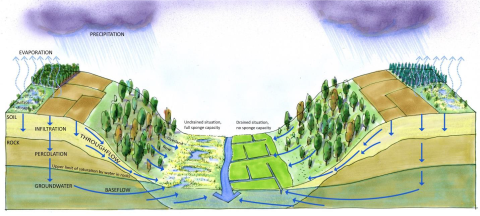Restoration of marshes in the Rhine basin for flood and drought risk reduction

Natural water retention measures can help reduce flood and drought risks in Europe. Restoration of the water storage capacity of marshes in the upstream section of the Rhine river basin is a nature-based solution for water management which could additionally generate socio-economic benefits.
Rewetting floodplain marshes is a nature-based solution for retaining water in the soil. Floodplain restoration measures address the problem of flood peaks and droughts by slowing down the discharge of water into the river. Restoration of floodplain marshes, starting locally in the capillaries of the catchment, is a relevant option in a wider range of tools for water management. It would contribute to the recovery of the floodplain’s capacity to retain water during times of high precipitation, thus reducing flood peaks. The water’s subsequent release from the organic and spongy soils may also contribute to securing a prolonged release of water during drought periods. Restoring these marshes would in addition provide the benefit of carbon sequestration as well as recovery of natural habitat and ecosystems that have been lost along the river.

Restoration of marshes could potentially have a large effect on reducing flood risks in the wider catchment, if it would be implemented on a larger scale. A transboundary, river-basin approach is consistent with the objectives of the EU Flood Directive and Water Framework Directive. The concept also fits the aims of the EU Green Infrastructure Strategy as well as the greening transition within the Common Agricultural Policy (CAP).
Challenges
Climate change will impact all regions in Europe. According to the European Environment Agency [1], precipitation has generally increased in northern and north-western Europe, leading to increased river flows and risks of flooding. Heavy showers will occur more often, bringing large quantities of rain in a short period. In Central Europe, decrease of summer precipitation could lead to critically low water levels.
Meanwhile, European regions have become less resilient to extreme situations due to increased urbanisation, channeling of streams and rivers and drainage of land for agriculture. The water system has become less robust, resulting in more floods, damage, and fatalities. An example are the floods that hit Germany and France after several days of heavy rain in June 2016.
The Rhine river has lost about 85% of its original floodplain and with that, the river’s capacity for flooding. Large scale drainage has taken place in the sloping hills and valleys of the catchment, which discharge their water into (the tributaries of) the Rhine. Consequently, water flows faster downstream than ever before, causing higher flood peaks and longer periods of drought.
[1] EEA, Climate change impacts and adaptation
Project
Wetlands International – European Association and WWF-Netherlands collaborate in a project aiming to convince policy makers and other relevant actors that restoring the sponge capacity of the soil is a feasible and efficient, nature based solution for water management, whilst generating economically and societally significant co-benefits. The project encompasses a cost-benefit analysis of the case for restoration of the marshes in the low mountain ranges of the Rhine, basin with participation of relevant stakeholders. A business case for implementation of natural water retention measures will be elaborated.
Visit our publication page to download the final report of this project.
Donors
Michael Otto Stiftung
European Commission
Partners
World Wide Fund for Nature in the Netherlands
Bureau Stroming
UDATA
Header image © Dirk Oomen
